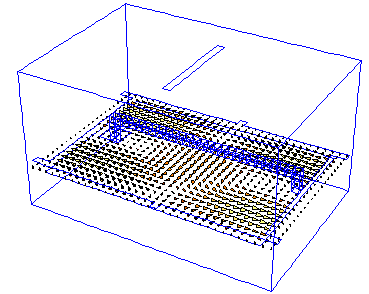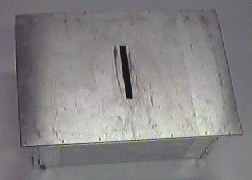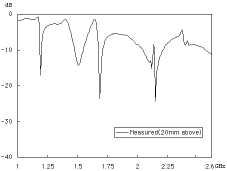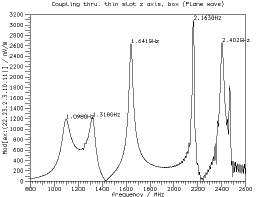Dissertation
( Tokyo University of Science, March 1998 )
Research on the Electromagnetic Susceptibility
of Equipment Housing with an Aperture
Hiroaki KOGURE
 東京理科大学大学院博士課程(社会人特別選抜) 小暮裕明
東京理科大学大学院博士課程(社会人特別選抜) 小暮裕明
- Summary of Dissertation -
Chaper 1 - Introduction
Extensive studies have been made regarding the influence of incident electromagnetic waves on electronic circuits that are placed in the open space. In practice, however, electronic circuits are rarely used by themselves, exposed in the open space, but are arranged on a PCB and installed inside an equipment housing. Few discussions have been made on the susceptibility or immunity of the circuits under such a practical condition.
With the PCB contained in an equipment housing, it is often necessary to cut some openings on the walls of the housing. For example, there must be a narrow slot for inserting a floppy disk or CD-ROM, a small opening for the power cord, or openings for heat dissipation. Electromagnetic energy coupled into the housing by way of such an opening could cause serious troubles to the circuits inside. So, from the standpoint of immunity of circuits, it would be very helpful if we could evaluate, at the time of equipment design, the EM susceptibility of the PCB inside the housing as functions of frequency and, also, of the installation position of the PCB.
This dissertation describes a research on evaluating the electromagnetic susceptibility inside the equipment housing to incoming electromagnetic waves through an aperture on the housing wall. The field distribution inside the housing and, also, the current induced in a transmission line on a PCB placed inside the housing were analyzed by the method of moments and the transmission-line modeling method. Results of the analysis showed a good agreement with the results of measurement. Also, it is found that the susceptibility of the PCB shows peaks at some frequencies that depend almost solely on the structure of the housing and the aperture and, therefore, can be estimated at the time of equipment design.
Chaper 2 - Electromagnetic Analyses
One of the software used for the analysis is KCC "Micro Stripes" based on the transmission-line modeling method which is developed by Dr. Peter B. Johns. In this method, the space for analysis is discretised into many rectangular cells. The electromagnetic field excitation in each cell is modeled using 3-D transmission junction called node. The model is excited by introducing voltage pulses at the nodes, which travel along the transmission lines, scatter at the junctions and connect across to adjacent nodes. The scatter-connect process is repeated until a sufficient number of time-steps have been computed to simulate the impulse response of the complete structure.
By using the TLM method, the author have conducted such evaluation for a housing cubicle of dimensions 300x150x200[mm] . It has a narrow slot 10mm wide and 100mm long at the center of the top plate. A plane wave is assumed to be excited at 50mm above the slot.
Another software used for the analysis is Sonnet "Em" based on the method of moments. The technique used in this software is a Galerkin implementation of the method of moments developed as an extension of an analysis of planar waveguide probes by Dr. James C. Rautio.

(Magnetic field distribution between PCB layers)
Chaper 3 - Resonance Inside Equipment Housing
It can be inferred that we may adduce the following two reasons to explain why the electromagnetic field inside the housing shows sharp peaks at some particular frequencies.
1) Acting as a slot antenna the narrow slot re-radiates into the housing most strongly at the resonant frequency of the slot antenna, which corresponds to the first peak.
2) As a rectangular resonant cavity, the housing shows a number of normal resonant modes.
These normal resonant frequencies are calculated from the housing dimensions.

The equipment housing for the experiment is composed of six aluminum plates of 1.5mm thickness joined by means of screws, all joints between the plates being sealed by copper foil.
The TLM method makes it possible to obtain the electric field intensity at any point in the model structure. For example, the electric field at a center point 30mm above the bottom plate of the housing (with the incoming wave polarized in the x direction) as a function of frequency. The analysis shows a peculiar frequency characteristic that would result if the housing cubicle acted like a rectangular cavity resonator.


(Measured S11 and Electric field Ex inside housing)
As it is difficult to directly measure the electric field inside the housing by experiment, the reflection from the top plate is measured instead to evaluate the resonant frequencies of the housing cavity. A plane wave is radiated from a double-ridge guide antenna at 30mm above the top plate of the housing, and the reflection coefficient S11 at the antenna is measured with a network analyzer. It is seen that most of the incoming wave is reflected from the top plate, but there are sharp dips in the S11 characteristic at some frequencies approximately corresponding to the peaks frequencies. Thus, it can be reasoned that at these frequencies, a considerable amount of the incoming electromagnetic energy is coupled into the housing through the aperture.
Chaper 4 - Estimation of Electromagnetic Field Coupled into Equipment Housing with an Aperture
It was shown that an aperture at a waveguide termination is represented as the admittance of an aperture by the equivalent circuit theory. According to this theory many equations were derived. In the vicinity of a resonant frequency, whole structure of equipment housing with a slot is represented as series RLC circuit and admittance of an aperture. To evaluate these equations, the test model which is equal to the simulated structure was calculated and found to give a good approximation to the problem.
Chaper 5 - Electromagnetic Susceptibility of Equipment Housing with an Aperture
The PCB is also modeled by the TLM method and excited by the same plane wave. The induced current is seen to show several peaks at frequencies approximately corresponding to the resonant frequencies.
Similar simulations for the induced current have been conducted for multi-layer PCB's and for various positions of the PCB inside the housing.
Chaper 6 - Definition of Electromagnetic Susceptibility
The Electromagnetic Susceptibility (EMS) is newly proposed by the author as "the electromagnetic energy coupled to the circuit inside housing" divided by "the electromagnetic energy coupled into the housing through the aperture" in percentage.
Chaper 7 - Conclusion
Special thanks to
Sonnet Software, Inc.
Kimberley Communications Consultants Ltd.
